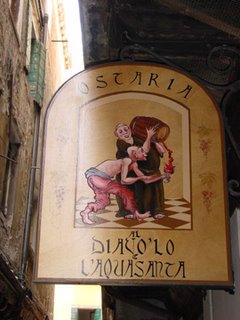 In the Veneto, legend has it that a monk got into a little trouble with the devil. The monk, Fra Stefano, wanted to make the greatest wine that had ever been made. Inspired by the miracle at Cana when Jesus turned water into wine, this monk filled his barrels up with holy water and called upon an unothodox power to help transform this into wine. A certain fellow, but a diabolical one at that, came upon the scene and offered to help this monk in exchange for his soul. This being harvest time and the monk wishing to enjoy the fruits of his labors, he bartered with the devil to let him have his soul until the end of spring. Now this monk wasn’t too good with time and numbers and when pressed by the devil for a definite date, the monk said, “the 31st of June”. At which time he and the devil made their deal. It seems the devil was none to good at time and numbers as well. But a deal is a deal even when one makes it with the devil. Oh, what a good wine it was!
In the Veneto, legend has it that a monk got into a little trouble with the devil. The monk, Fra Stefano, wanted to make the greatest wine that had ever been made. Inspired by the miracle at Cana when Jesus turned water into wine, this monk filled his barrels up with holy water and called upon an unothodox power to help transform this into wine. A certain fellow, but a diabolical one at that, came upon the scene and offered to help this monk in exchange for his soul. This being harvest time and the monk wishing to enjoy the fruits of his labors, he bartered with the devil to let him have his soul until the end of spring. Now this monk wasn’t too good with time and numbers and when pressed by the devil for a definite date, the monk said, “the 31st of June”. At which time he and the devil made their deal. It seems the devil was none to good at time and numbers as well. But a deal is a deal even when one makes it with the devil. Oh, what a good wine it was!
* * * * * * * * * * * * * * * * * * * * * * * * * * * *
A young man arrived in the Veneto, in a small town where the Prosecco wine is made.

The town, Rolle, is very near the epicenter of the Prosecco heartland, Valdobbiadene. He had read about this area for some time now, the prospect of anticipation was now a reality.
As he settled in his room for the night, in an inn that had once been an abbey, he felt a serene familiarity with his surroundings. It was as if he had been reminded of something that hadn’t yet happened.
Valdobbiadene and the surrounding area is a fantasy land for wine and food lovers.  One hour or so from Venice, but light years from the tourists and the hype and the come on. No menu turistica, no pizza, no gondolas. There is something wonderful about the sound of the church bell ringing at 6:45 in the morning calling the people to mass and the workers to their labors. As it has been for centuries. Roosters crow, doves coo and cuckoos announce the dawn add to the symphony of the hills. There is a peace in these valleys that resonates in ones soul long after one is back home.
One hour or so from Venice, but light years from the tourists and the hype and the come on. No menu turistica, no pizza, no gondolas. There is something wonderful about the sound of the church bell ringing at 6:45 in the morning calling the people to mass and the workers to their labors. As it has been for centuries. Roosters crow, doves coo and cuckoos announce the dawn add to the symphony of the hills. There is a peace in these valleys that resonates in ones soul long after one is back home.
 The wine is simple. It’s white and often bubbly. Fresh and lightly fruity. Now it is fashionable in places like San Francisco and New York, but fashion from this place seems odd. The spirit of here whispers, “Timeless”. Some of the winemakers the young man will visit are Mionetto, Montesel and Bisol, all from the land of the Valdobbiadene.
The wine is simple. It’s white and often bubbly. Fresh and lightly fruity. Now it is fashionable in places like San Francisco and New York, but fashion from this place seems odd. The spirit of here whispers, “Timeless”. Some of the winemakers the young man will visit are Mionetto, Montesel and Bisol, all from the land of the Valdobbiadene.
The problem with fashion is that it overlooks the 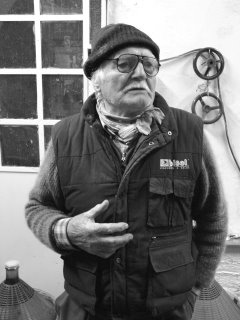 timeless for the new. Our societies in Italy and America are rapidly paving over the traditions once held in high regard. And with it go the people and the stories. People like Giuseppe, who owns a small plot of land clinging to a hill in Valdobbiadene. An octogenarian who rises at four in the morning to go out and work in his vineyard. The children have moved away to Milan to become accountants and pharmacists. They will never get home by the 31st of June. His way is dying and he tells me he fears this way of life will go when he goes. No legacy buyout from a corporation wishing to further his work into the future.
timeless for the new. Our societies in Italy and America are rapidly paving over the traditions once held in high regard. And with it go the people and the stories. People like Giuseppe, who owns a small plot of land clinging to a hill in Valdobbiadene. An octogenarian who rises at four in the morning to go out and work in his vineyard. The children have moved away to Milan to become accountants and pharmacists. They will never get home by the 31st of June. His way is dying and he tells me he fears this way of life will go when he goes. No legacy buyout from a corporation wishing to further his work into the future.
Sergio  Mionetto sold his company some time ago but remains with the company as their spokesman and spiritual compass. The company now embraces modernity and innovation, hoping to reach a larger audience of Prosecco-isti. Sergio, meanwhile, has become a living symbol of those hills, etched on his face like the gulleys of his beloved Cartizze, a small drop of a land that is thought to be a place where the terroir of the Prosecco has its greatest potential. Only 106 hectares. Here the land is some of the most valuable in Italy, valued at $1,000,000 euro per hectare. On this land are more souls who work the land, become the land, who breathe out of that soil nectar that seldom is found in the land. Sell their land? Not likely.
Mionetto sold his company some time ago but remains with the company as their spokesman and spiritual compass. The company now embraces modernity and innovation, hoping to reach a larger audience of Prosecco-isti. Sergio, meanwhile, has become a living symbol of those hills, etched on his face like the gulleys of his beloved Cartizze, a small drop of a land that is thought to be a place where the terroir of the Prosecco has its greatest potential. Only 106 hectares. Here the land is some of the most valuable in Italy, valued at $1,000,000 euro per hectare. On this land are more souls who work the land, become the land, who breathe out of that soil nectar that seldom is found in the land. Sell their land? Not likely.
A visit to a farm in the hamlet where the Prosecco of Cartizze is grown. Here in 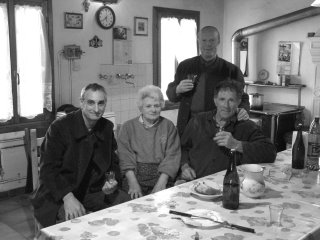 this land one doesn’t find over stuffed mansions of 10,000 square feet with 5 bedrooms and 6 bathrooms, for only two people. Here is a small house with a wood burning oven, home made bread, cheese and wine. And two very content and happy people who live there. Looking at the purity of their smiles, the clarity in their eyes, the simplicity of their lives, these are people rich beyond the value of their land, wealthy beyond trust funds.
this land one doesn’t find over stuffed mansions of 10,000 square feet with 5 bedrooms and 6 bathrooms, for only two people. Here is a small house with a wood burning oven, home made bread, cheese and wine. And two very content and happy people who live there. Looking at the purity of their smiles, the clarity in their eyes, the simplicity of their lives, these are people rich beyond the value of their land, wealthy beyond trust funds.
During the early spring the winemakers 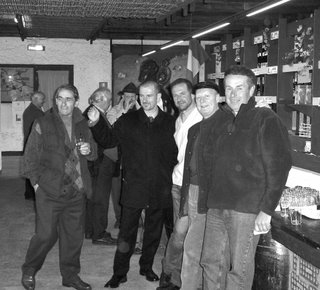 put on an exhibition of their wines in the
put on an exhibition of their wines in the
little towns. In one of these Sergio gathers with some of his friends and colleagues, journey men and apprentices. A modern day guild of sorts, this one to celebrate the miracle of grapes into wine. Without the devil and the holy water. Who wouldn’t want to be part of that happy gathering? What a life!

Renzo Montesel started as an agronomist for the region. On the outer edge of the Valdobbiadene zone, in Colfosco, He and his wife have a small farm. Their vineyard, the Vigna Paradiso, sits on tufa rock, porous soil that has excellent drainage and exposure. The wine has an infinitely fine mousse. These are younger people and with them comes the hope that some of the living legacy of
the elders will live on in the labors of Renzo and his wife Vania. Their wine is ‘hand-made’ and rivals the best the region has to offer in Prosecco.
The Bisol family is equally understated in

their outward appearances, but here is where the Prosecco finds an anchor. One of the largest landowners in the Cartizze (they hold 3 hectares) and gregarious in their reach. Their vines cover 50 hectares (where the average vineyard holding is 1 hectare); their family offers wine growing classes, wine tasting seminars and traditional cooking courses from their hospitality center, the Foresteria Duca di Dolle. Here one can lose oneself, or perhaps really find ones true reason for being. The opportunity is here in many ways.
And tonight this young man on his way back from several days out in the field with these beacons of inspiration. On his way back to the room he picks up a book, about an older man of the village. His life, his story, this man who after a period of traveling while young, came back to this little village and lived his life. How oddly familiar this story was to the young man, but only in the way one can sense something that might be about to happen, what they call déjà vu.
The next morning the young man, sitting out among the vineyards taking in the morning, was filled with light and an understanding of the cycle of the old mans life and his, entwined like the vines and the poles holding them up. As the church bells tolled, it was as if the life of the grapes made to sparkle infused within him to the point of immersion into the territory. He was becoming part of the terroir as a flower would bloom, a bird would sing.
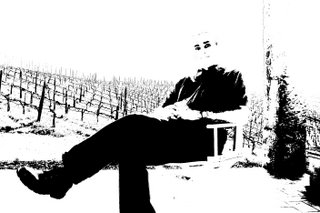
It was then the young man knew that book about the old man's life was about the life he was about to start living, in an amazing place, in the hills above Venice.

June 31st had arrived.
* * * * * * * * * * * * * * * * * * * * * * * * * * * *
RESTAURANTS IN ROLLE
In this small, fascinating borgo there are two very renown restaurants: Da Andreetta and Locanda al Monastero, where it is possible to taste some fine local dishes, according to the culinary tradition of the Prosecco hills.
Seasonal products are an extremely important ingredient in the preparation of the menus: Mushrooms, Treviso Red Chicory, Spontaneous Wild Herbs, Asparagus, cheese from the Pre Alps, are just a few of the options available to the chefs. Wonderful al fresco dining in summer and excellent fireside dining in winter.
Ristorante da Andreetta – Terrazza di Rolle
Address: Via Enotria 7 Rolle (Treviso)
[this web site has additional information on Rolle ]
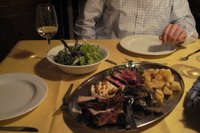 Locanda al monastero
Locanda al monastero
Menu changes daily according to the seasonal offerings. My vote for last meal on earth. Address: Via Enotria 21 Rolle (Treviso)
 RESTAURANT IN MAINE
RESTAURANT IN MAINE
Ristorante 'Da Gigetto'
An absolute pilgrimage to a shrine for food and wine. One of the best experiences I have ever had.
via A. De Gasperi, 4.31050 Maine
Trevisio
Italy
STAY IN ROLLE
A relaxing and pleasant stay at the “Foresteria Duca di Dolle” will be an unforgettable experience, where enjoying fine wine and cooking classes, visits to artistic sites and excellent local restaurants, mountain biking, walking, where getting what every body is looking for: the perfect balance between mind and body, can transpire.
LOCAL & REGIONAL FOOD FESTIVALS (SAGRAS) TREVISO PROVINCE
This land invites you to celebrate the joy of life. The gourmets will find their paradise in this area: in any season, local products are used to create fine typical dishes, and are presented in excellent restaurants and unique gastronomic festivals held all over the Treviso Province. Festivals are just some of the many interesting events to take part in while visiting Rolle.
Cocofungo (mad for mushrooms) - October
Cocoradicchio (mad for radicchio) - Febrary
The Radicchio di Treviso Festival - December
The Combai Chestnuts Festival - October
The Prosecco Spring Festival March - June
Amopesce (fish festival in April)
Riso e Verdiso… - middle of May
The Mostra Nazional degli Spumante Exhibition - September (held at the beautiful Villa dei Cedre in Valdobbiadene. An Italian Exhibition of over a thousand extraordinary, unique and sparkling wines).
Vino in Villa - last week-end of May (organized from Consorzio Prosecco of Conegliano-Valdobbiadene)
producers
Mionetto
Via Colderove, 2
Valdobbiadene 31049
Tel: 0423.9707
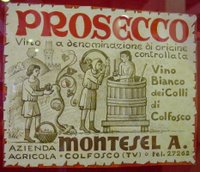
Montesel
Via S. Daniele 42
Colfosco Di Susegana, 31030
Tel: 0438.781.341
no web site
Bisol
S. Stefano di Valdobbiadene 31040
Tel: 0423.900.138
 La missione di Federlombarda. Chiusa ieri la promozione delle eccellenze lombarde
La missione di Federlombarda. Chiusa ieri la promozione delle eccellenze lombarde essere presentati con il loro, straordinario retroterra di cultura, di lavoro. In particolare ha molto colpito il fatto che il procedimento di preparazione del Gorgonzola e del Taleggio sia stato scoperto 600-700 anni prima della fondazione di Dallas. Eccellente l’impatto dei vini di Franciacorta, meritato il successo dell’azienda ‘Cà del Bosco’ (presidente Maurizio Zanella, enologo Stefano Capelli); una sorpresa i grandi vini della Valtellina, qui presentati come il prodotto della più grande area viticola terrazzata di montagna e trascinati dallo Sforzato (o Sfursat), vino simbolo di Valtellina Docg, ottenuto dall’appassimento delle uve nebbiolo (ma citati sono stati pure i vari Sassella, Inferno, Grumello, Vagella e Maroggia). Infine commenti ampiamente positivi per l’olio extravergine di oliva ‘Garda’ Dop, denominazione (così è stato spiegato) condivisa con il Veneto e il Trentino. Insomma I ‘magnifici sette’ sono parsi la sintesi, emblematica, di un mosaico di sapori che dalle vallate alpine alla Bassa Padana, caratterizzano la Lombardia sul versante della varietà (ricordate anche le carni, i salumi, i cereali) e della qualità. Valori che i texani hanno colto con immediatezza già il primo giorno al ‘Southwest Food Service Expo’ e poi con i vari seminari che sono stati organizzati con relative degustazioni al ‘Viking Culinari Arts Center’ (i vini sono stati illustrati dal sommelier Alfonso Cevola). Conclude Mario Maestroni: «Credo che il sistema americano sia proprio rimasto soddisfatto. Ora non resta che rafforzare i rapporti».
essere presentati con il loro, straordinario retroterra di cultura, di lavoro. In particolare ha molto colpito il fatto che il procedimento di preparazione del Gorgonzola e del Taleggio sia stato scoperto 600-700 anni prima della fondazione di Dallas. Eccellente l’impatto dei vini di Franciacorta, meritato il successo dell’azienda ‘Cà del Bosco’ (presidente Maurizio Zanella, enologo Stefano Capelli); una sorpresa i grandi vini della Valtellina, qui presentati come il prodotto della più grande area viticola terrazzata di montagna e trascinati dallo Sforzato (o Sfursat), vino simbolo di Valtellina Docg, ottenuto dall’appassimento delle uve nebbiolo (ma citati sono stati pure i vari Sassella, Inferno, Grumello, Vagella e Maroggia). Infine commenti ampiamente positivi per l’olio extravergine di oliva ‘Garda’ Dop, denominazione (così è stato spiegato) condivisa con il Veneto e il Trentino. Insomma I ‘magnifici sette’ sono parsi la sintesi, emblematica, di un mosaico di sapori che dalle vallate alpine alla Bassa Padana, caratterizzano la Lombardia sul versante della varietà (ricordate anche le carni, i salumi, i cereali) e della qualità. Valori che i texani hanno colto con immediatezza già il primo giorno al ‘Southwest Food Service Expo’ e poi con i vari seminari che sono stati organizzati con relative degustazioni al ‘Viking Culinari Arts Center’ (i vini sono stati illustrati dal sommelier Alfonso Cevola). Conclude Mario Maestroni: «Credo che il sistema americano sia proprio rimasto soddisfatto. Ora non resta che rafforzare i rapporti».


 When I walked into Palermo with patched jeans, desert boots and some crazy shirt, along with my lengthy curls, peace signs and surplus army camera bag, folks looked at me as if I were from another planet. I was.
When I walked into Palermo with patched jeans, desert boots and some crazy shirt, along with my lengthy curls, peace signs and surplus army camera bag, folks looked at me as if I were from another planet. I was.  Looking around then, all I saw was the future running from the past. Looking around now, all I see is the future then.
Looking around then, all I saw was the future running from the past. Looking around now, all I see is the future then.











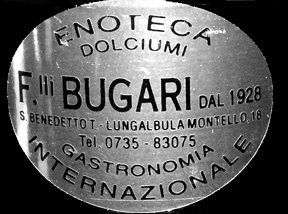



























 RESTAURANT IN MAINE
RESTAURANT IN MAINE
